Outdoor spaces: designing for all children
Outdoor space provides ideal conditions for free play, adventure, risk taking and challenge. Play opportunities should be freely available, accessible, appropriate and well-resourced with toys and play materials. Provide as much open space as possible to enable children to run, jump and climb. The guidance here relates to all children, but later in this section (page 204) we look at the specific requirements of children under 2-years in outdoor areas.
Toys and play materials influence the social, emotional and cognitive affordances of play and the quantity and quality of available materials requires careful consideration. It is important to balance structured materials with more unstructured or open-ended materials such as featureless toys and loose parts.
Materials which are more open-ended and suggest many possible uses are increasingly associated with high quality learning. Natural materials offer more possibilities as they have multiple uses and consequently inspire a range of creative and problem-solving behaviours. When organising the outdoor environment, it is important to facilitate children using materials from various areas. This ensures freedom, choice and exploration.
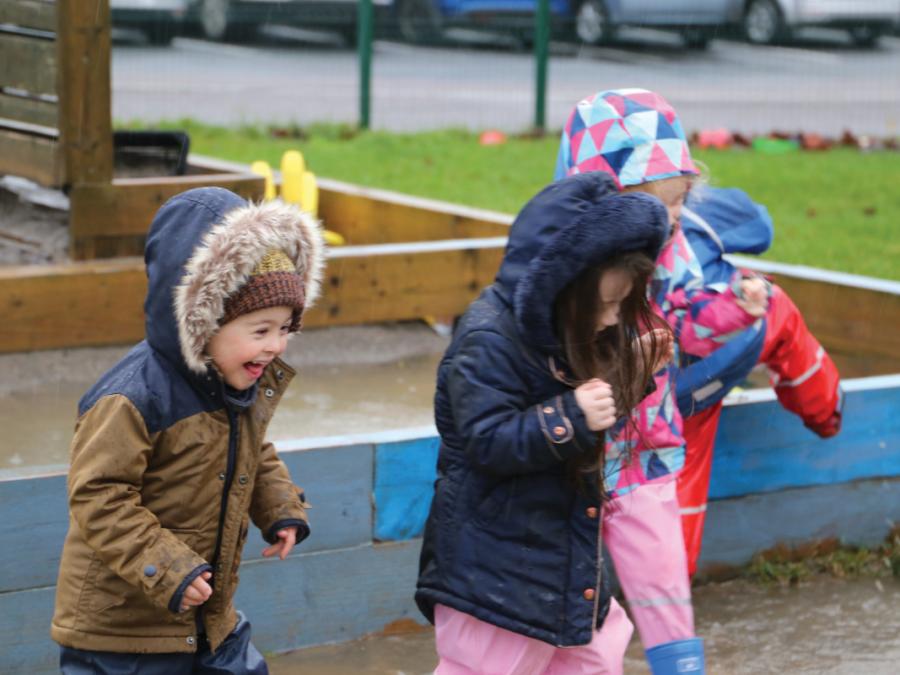
56. Waterford Childcare Centre, Waterford City
Open-ended materials, also called loose parts, are materials, such as blocks, stones and reels, that can be used in numerous ways, indoors and outdoors, by babies, toddlers and young children. They can be moved, carried, combined and redesigned in any way the child decides. For more information see:
The environment needs to balance young children’s need to revisit favoured play materials with their need for new and novel experiences. This can be achieved through rotating materials and introducing new materials. Toys and play materials should be evaluated in terms of their potential to promote:
- Thinking and learning (e.g. studying objects or commenting on new discoveries).
- Problem-solving (e.g. overcoming challenge).
- Curiosity and inquiry (e.g. engaging in exploration/experimentation).
- Sustained interest (e.g. persisting).
- Creative expression (e.g. using toys in novel ways).
- Symbolic transformations (e.g. making one thing represent another).
- Interacting, communicating, and collaborating with peers.
- Autonomous play with toys (e.g. without adult assistance).
- Space to run, jump and climb.
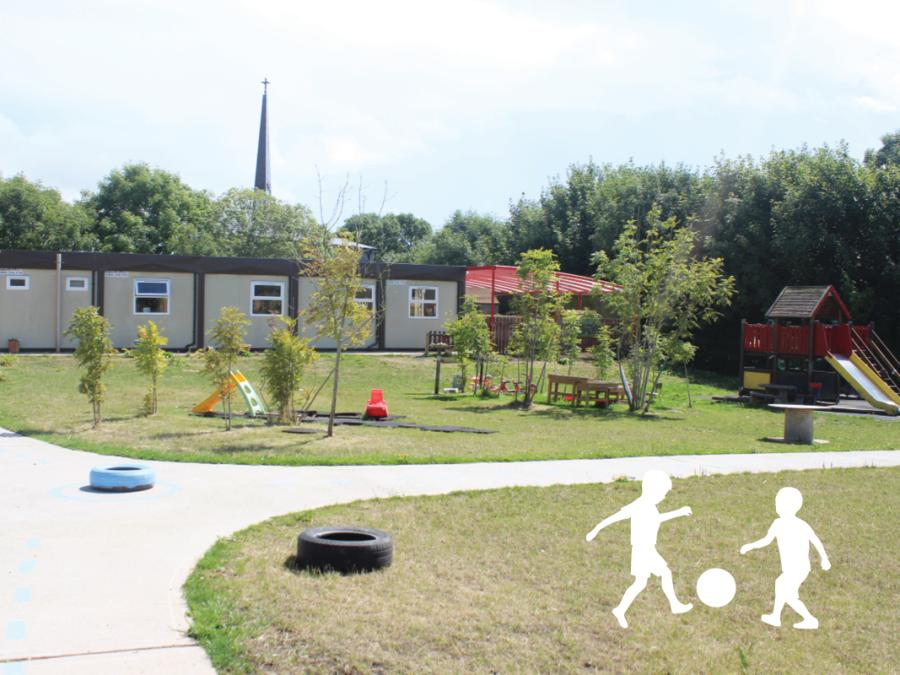
57. Aghada Community Preschool, Aghada, County Cork
Aghada Community Preschool, Aghada, County Cork.
Design features
- The outdoor area provides varied experiences for children, ranging from planting, (so children can observe plants and trees growing and smell scents such as herbs and scented flowers) to hard surface paths for trikes and tractors and a slide so children can access fixed apparatus.
- There is ample open space, so children can run, jump and climb.
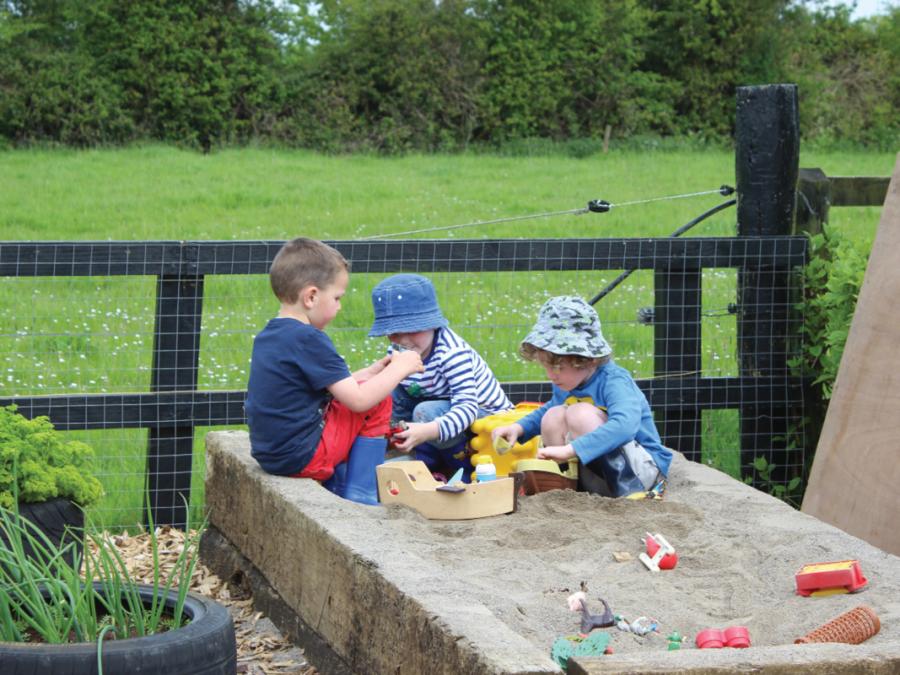
58. Bernie’s Pre-school, Knockainey, County Limerick
Bernie’s Pre-school, Knockainey, County Limerick.
Design features
- The large sand pit gives children the opportunity to explore sand and provides
for children to climb in to it.
Design tip
- Ensure the sand pit drains well so water does not pool in very wet weather.
The outdoor play environment offers unique opportunities in terms of readily available natural play materials which allow children to take responsibility for building their own play environment. Traditional play activities such ‘den making’ are highly attractive to children, encourage engagement with natural materials and loose parts, inspire various types of play such as constructing and pretence, and encourage collaboration between peers as children use materials to build their own play environments.
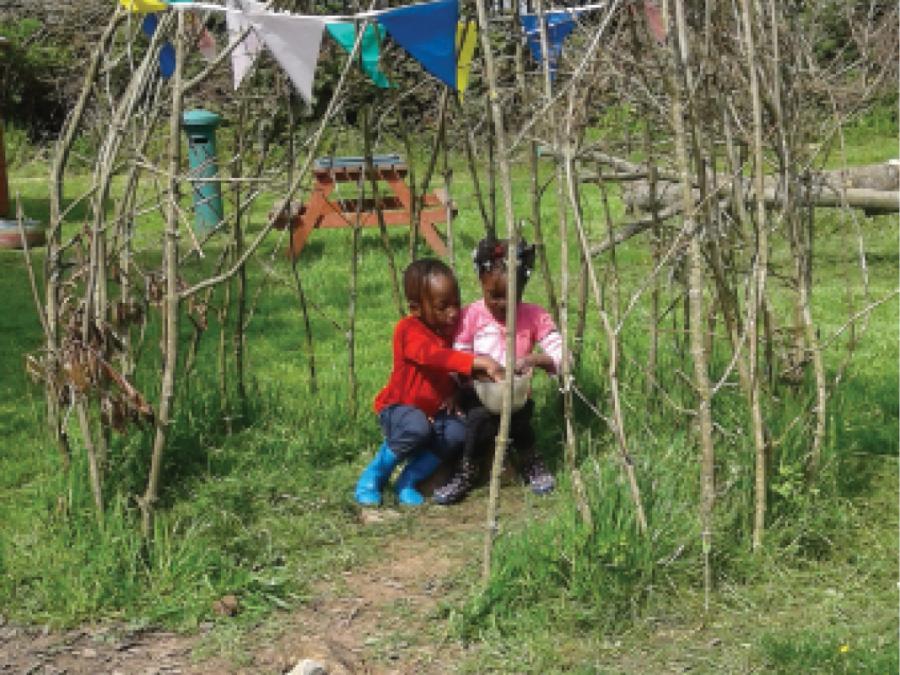
59. Lux Children’s Club, Moate, County Westmeath
Lux Children’s Club, Moate, County Westmeath.
Design features
- The use of willow provides a den type space for children to experience enclosure and privacy, while enabling supervision.
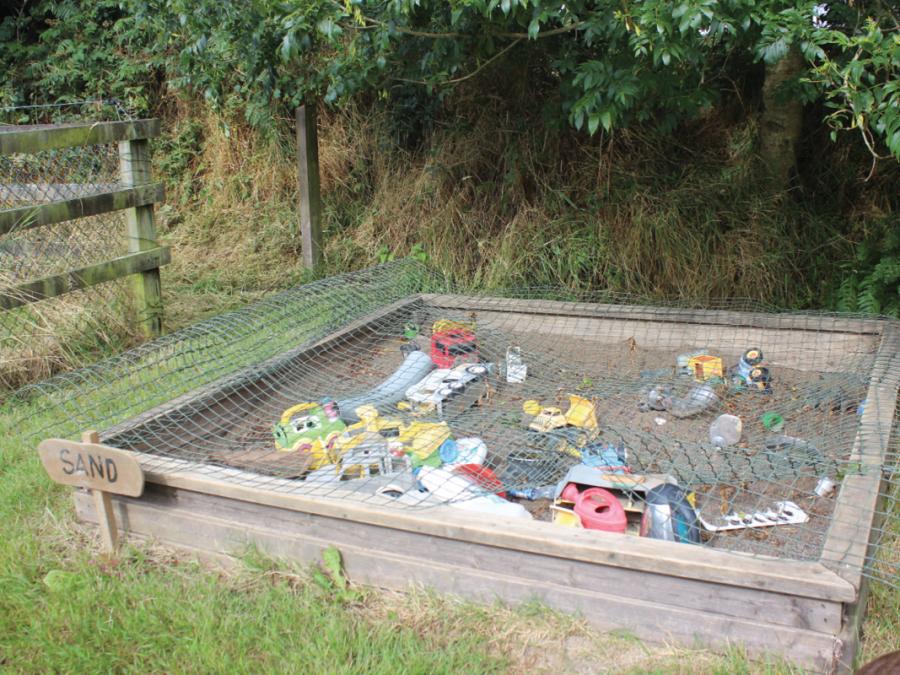
60. Puddleducks Playschool, Ballylanders, County Limerick
Puddleducks Playschool, Ballylanders, County Limerick.
Design features
- A large outdoor sand pit allows for a number of children to play together.
Design tip
- A solid lid would prevent animal access and avoid water stagnation.
Outside space provides opportunities for a greater variety of natural materials and sensory experiences. Outdoor space should allow children to experience nature, to feel the grass under their feet, to grow things, to climb trees, and to get dirty. A good outdoor area requires multiple spaces, surfaces and materials to provide the variety of experiences required.
When multiple materials and finishes are present in an outdoor space, the following should be considered:
- Surfacing should not have any sharp protrusions or edges.
- It should have no entrapments (small gaps where fingers or feet could get caught).
- Impact absorbing surfaces should be used where falls over 600mm are possible.
- The minimum thickness of impact absorbing tiles is 25mm. The edging and joints between the tiles should not form a trip hazard and ideally should be at the same level as the surrounding hard surfacing.
- Hard surfaces should only be used outside the impact area.
- Topsoil or turf may be used in areas where falls will be from heights no greater than 1m.
- Loose fill impact absorbing surfacing includes sand and bark chips which should be installed to a minimum depth of 300mm.
- Materials should be laid to prevent pools of water from gathering. Small grated drains may need to be fitted. Such grates should be located strategically so any excess surface water is drained away.
- Hard surfaces should be used where there is constant play and for paths, but never where climbing takes place.
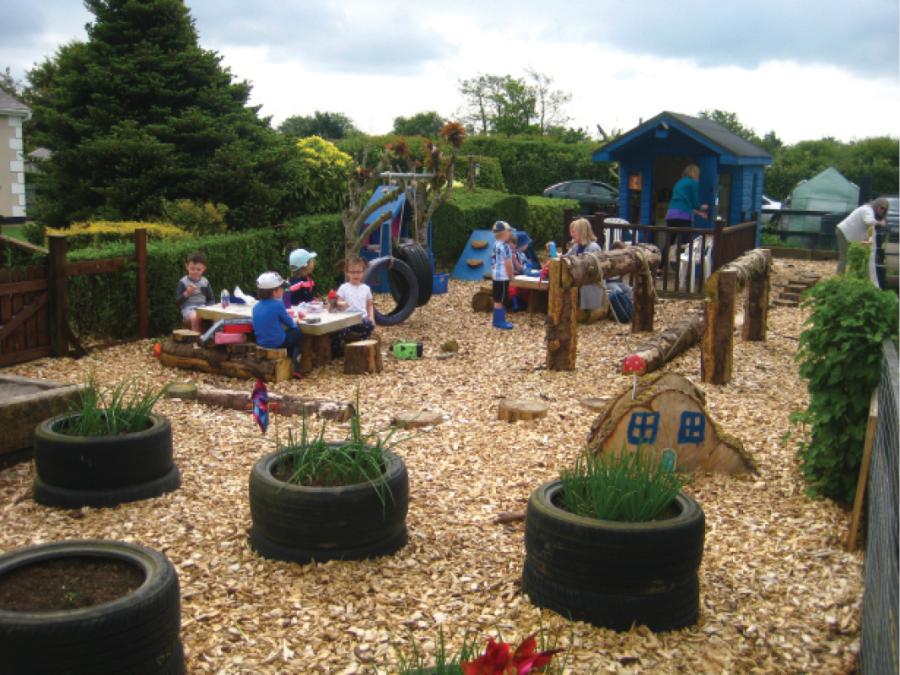
61. Bernie’s Pre-school, Knockainey, County Limerick
Bernie’s Pre-school, Knockainey, County Limerick.
Design features
- Natural materials and objects used to create a stimulating and healthful environment for children.
Design tip
- Ensure suitable, firm access routes to and within areas where there is bark mulch to enable all children and adults to use it.
Children of varied ages, staff or visitors with differing physical, sensory or cognitive difficulties will have diverse needs within the outdoor space and therefore Universally Designed surfaces and finishes need to be considered. Many outdoor play areas provide barriers for children with sensory, physical or cognitive difficulties, for instance where sand causes difficulties for children in wheelchairs, or the use of grey coloured play equipment that is hard for children with visual difficulties to see. It has also been found that when children with physical, cognitive or sensory challenges could use the play area, they did not interact with their peers to the same extent as other children, because they were typically unable to use the space independently and often required assistance from an adult (see garden plan).
Ground surfaces in outdoor areas are a key part of their design, and as discussed above should provide a wide variety of experiences. Impact absorbing surfacing (IAS) may be appropriate in certain circumstances, but its use should be carefully considered, and it should only be used in areas of heavy wear, in locations where drainage is an issue, or in places where falls may occur from a height greater than 1m above ground level.
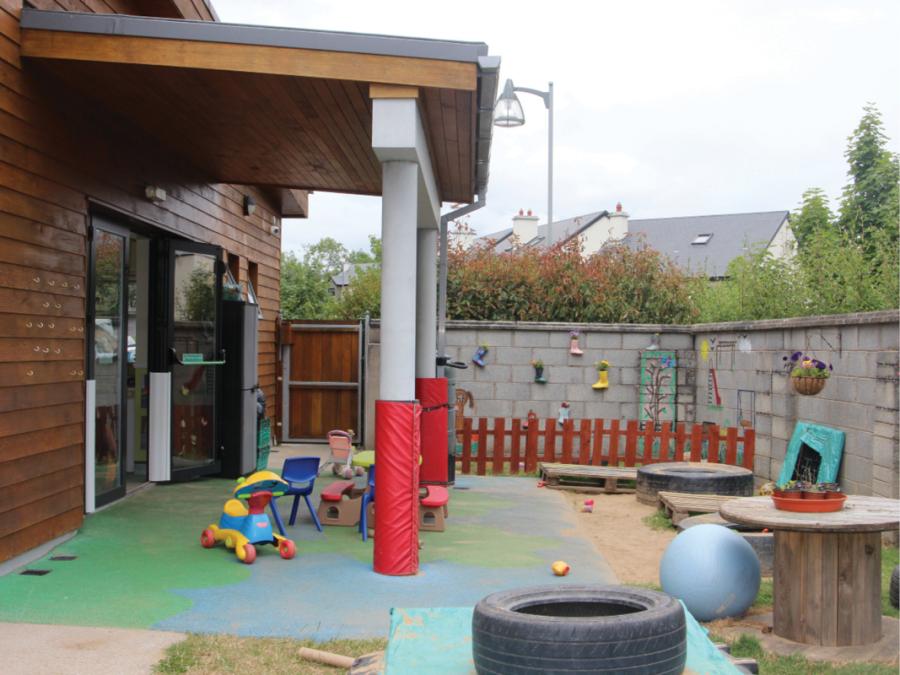
62. Crawford Childcare, Glanmire, County Cork
Crawford Childcare, Glanmire, County Cork.
Design features
- Subtle and minimal use of impact absorbing surfacing combined with grass and clay.
- The padding around the support columns ensures no injuries if a child bumps into a column.
Design tip
- Low level planting and climbing plants, in addition to the hanging baskets would soften the space.
In other areas, for instance where falls may occur from heights less than 1m and where heavy wear or drainage is not an issue, grass, mud, or wood chippings may be more appropriate. The use of natural materials is important, and a balance should be struck between loose fill natural materials (e.g. bark or sand), and synthetic material such as wet-pour, which will facilitate wheeled play and access for those with mobility difficulties. It should also be noted that smooth and level materials such as wet-pour will also support staff and visitors with sensory, physical or cognitive difficulties.
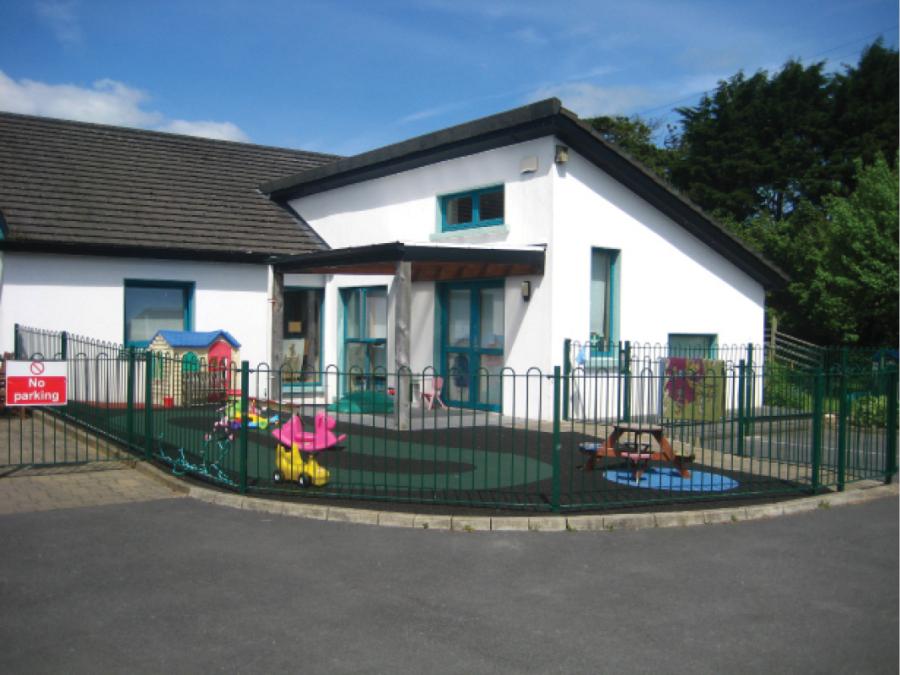
63. Ballindereen Community Childcare and Education Centre, Ballinderreen, County Galway
Ballindereen Community Childcare and Education Centre, Ballinderreen, County Galway.
Design features
- Small enclosed play space for infants and toddlers.
- Covered area providing shelter and shade as well as a transition space between indoors and outdoors.




